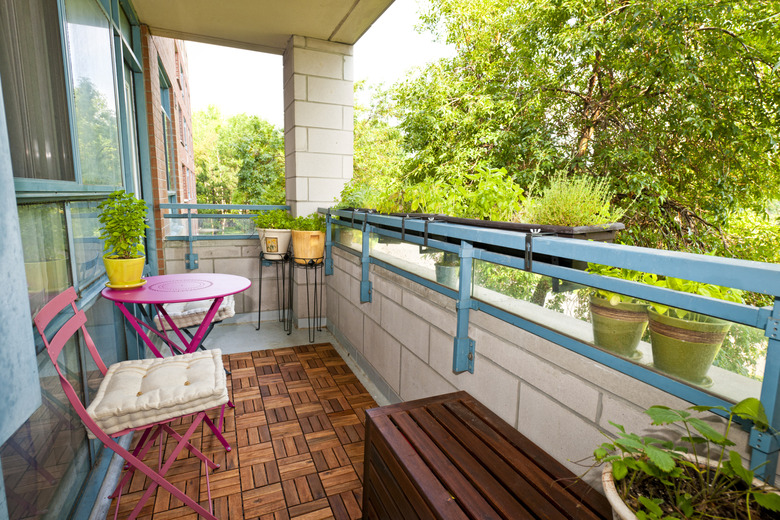How To Screen In Balconies
A balcony provides valuable outdoor living space with some built-in protection from the elements, but an open one does nothing to keep insects at bay. Screening the balcony in keeps pesky mosquitoes and flies out. A screen also stops little ones from throwing things over or between the railings. Adding the screen yourself can be done several ways; if you live in a condominium or apartment, check with the relevant organization first to be sure your method of installation is allowed.
Stick-On Screening
Stick-On Screening
Mosquito curtains, sometimes called outdoor curtains, provide an alternative to traditional window-screen material. Installing them with hook and loop tape makes them removable so you can take them down or put them back up at a moment's notice. Apply the scratchy side of a strip of sticky-backed hook and loop tape over the flat surface above the balcony opening across the front of the balcony. Staple or tack it down at the corners and once or twice along the span of the tape to help it stay put. Apply the fuzzy side of the hook and loop tape to the top of the mosquito curtain, stitching it in the corners with upholstery thread or fishing line to keep it intact. Stick the curtain up along the straight front area of the balcony, and then add hook and loop strips along vertical beams to keep the sides of the curtain in place. If the sides of the balcony are open, use separate curtains for those areas. Some companies sell custom-sized mosquito curtains, so you can have one specially designed for your balcony.
Traditional Staple Method
Traditional Staple Method
Staples hold window screen material in place for a quick screening-in project. Measure each area that requires a span of screen, and purchase a roll of screen with enough screen leftover in case of mistakes. Hold one edge of the screen up an inch or two from the opening along a vertical beam or post, stapling the screen down every few inches to the post or beam. Unroll enough material to span the entire balcony opening or at least reach the next post, stapling it to the ceiling as close to the opening as possible. Continue stapling as you go, keeping the screen taut. Once it's complete, add wood trim strips over the stapled area of the screen to mask the staples, trimming the screen to size with scissors, or tin snips for a metal screen.
Spline Simplicity
Spline Simplicity
Rubber spline designed to hold window screens in place provides a simple screening-in solution that does not require an abundance of staples. Fasten rubber spline strips to the vertical posts spanning the project area, using screws through the holes already on the splines. If necessary, trim splines to size using pruning shears. Press the screen into the grooves on the spline using a screen-spline tool. Add splines to the areas above and below the balcony opening and press the screen into the splines. A utility knife trims away excess screening.
Magnetic Personality
Magnetic Personality
Flat metal strips and strong magnets give you another way to hold screening in place. Thin, lightweight material such as mosquito-curtain fabric works best for the magnetic solution, because there is less space between metal and magnet. Install the metal strips along the perimeter of the balcony opening, along beams and boards — be sure to test the metal first with a magnet; aluminum will not work. Place one edge of the screen over its respective metal strip, and then stick the magnets over the strip to hold it down, repeating the process for the remaining sides of the screen. Trim the mosquito screening to size, if necessary, with scissors. This method offers another viable option if you wish to remove the screening from time to time.
